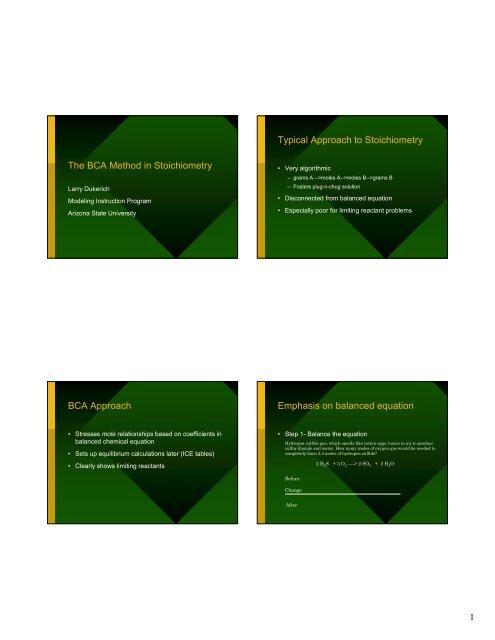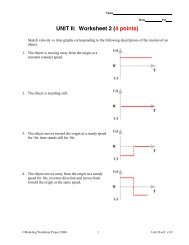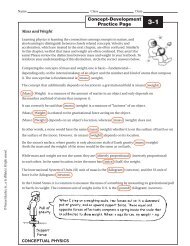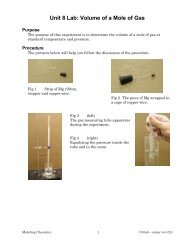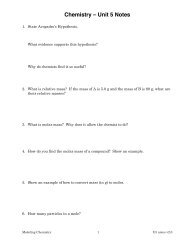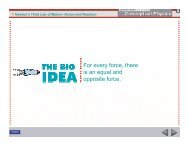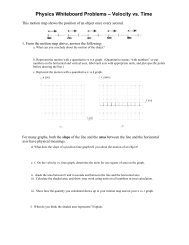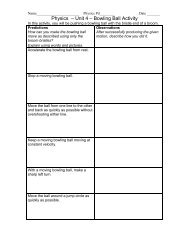BCA table lecture
BCA table lecture
BCA table lecture
- No tags were found...
Create successful ePaper yourself
Turn your PDF publications into a flip-book with our unique Google optimized e-Paper software.
Typical Approach to StoichiometryThe <strong>BCA</strong> Method in StoichiometryLarry DukerichModeling Instruction ProgramArizona State University• Very algorithmic– grams A -->moles A-->moles B-->grams B– Fosters plug-n-chug solution• Disconnected from balanced equation• Especially poor for limiting reactant problems<strong>BCA</strong> ApproachEmphasis on balanced equation• Stresses mole relationships based on coefficients inbalanced chemical equation• Sets up equilibrium calculations later (ICE <strong>table</strong>s)• Clearly shows limiting reactants• Step 1- Balance the equationHydrogen sulfide gas, which smells like rotten eggs, burns in air to producesulfur dioxide and water. How many moles of oxygen gas would be needed tocompletely burn 2.4 moles of hydrogen sulfide?2 H 2 S + 3 O 2 ----> 2 SO 2 + 2 H 2 OBefore:ChangeAfter1
Focus on mole relationshipsFocus on mole relationships• Step 2: fill in the before line2 H 2 S + 3 O 2 ----> 2 SO 2 + 2 H 2 OBefore: 2.4 xs 0 0ChangeAfter• Assume more than enough O 2 to react• Step 3: use ratio of coefficients to determinechange2 H 2 S + 3 O 2 ----> 2 SO 2 + 2 H 2 OBefore: 2.4 xs 0 0Change –2.4 –3.6 +2.4 +2.4After• Reactants are consumed (-), products accumulate (+)Emphasize that change and finalstate are not equivalentComplete calculations on the side• Step 4: Complete the <strong>table</strong>2 H 2 S + 3 O 2 ----> 2 SO 2 + 2 H 2 OBefore: 2.4 xs 0 0Change –2.4 –3.6 +2.4 +2.4After 0 xs 2.4 2.4• In this case, desired answer is in moles• If mass is required, convert moles to grams in theusual way3.6 moles O 2×32 .0 g1mole =115 g2
Percent Yield problems• <strong>BCA</strong> approach distinguishes between whatyou start with and what reacts. Changegrams to moles to begin.• Use the <strong>BCA</strong> <strong>table</strong> to determine moles ofproducts.• Change moles of products to grams usingmolar mass.Percent Yield problems• How many grams of aluminum iodide will form(theoretical yield) when 13.5 g of aluminumreacts with excess iodine?• 13.5 g Al x 1mole26.98 g= 0.50 molesPercent Yield problems• How many grams of aluminum iodide will form(theoretical yield) when 13.5 g of aluminumreacts with excess iodine?• 2 Al + 3 I 2 ----> 2 AlI 3Before: 0.50 xs 0ChangePercent Yield problems• 2 Al + 3 I 2 ----> 2 AlI 3Before: 0.50 xs 0Change -0.50 -0.75 +0.50After 0 xs +0.50After3
Percent Yield problems• Change moles to grams to finish.• How many grams of aluminum iodide will form (theoreticalyield) when 13.5 g of aluminum reacts with excess iodine?• 0.50 mol AlI 3 x 407.71 g1 mol200 grams of AlI 3 will form= 203.86 g = 2.0 x 10 2 gPercent Yield problems• If given the actual amount formed in lab –calculate % yield• How many grams of aluminum iodide will form (theoreticalyield) when 13.5 g of aluminum reacts with excess iodine?What is the percent yield if only 100 grams was formed inthe lab?• % Yield = actual yield/theoretical yield x 100• =100/200 x 100% = 50.% yieldOnly moles go in the <strong>BCA</strong> <strong>table</strong>Limiting reactant problems• The balanced equation deals with how many, nothow much.• If given mass of reactants for products, convert tomoles first, then use the <strong>table</strong>.• <strong>BCA</strong> approach distinguishes between what you start with andwhat reacts.• When 0.50 mole of aluminum reacts with 0.72 mole of iodine to formaluminum iodide, how many moles of the excess reactant will remain?How many moles of aluminum iodide will be formed?2 Al + 3 I 2 ----> 2 AlI 3Before: 0.50 0.72 0ChangeAfter4
Limiting reactant problemsLimiting reactant problems• Guess which reactant is used up first, then check2 Al + 3 I 2 ----> 2 AlI 3Before: 0.50 0.72 0Change -0.50 -0.75After• It’s clear that there’s not enough I 2 to react with all the Al.• Now that you have determined the limiting reactant,complete the <strong>table</strong>, then solve for the desiredanswer.2 Al + 3 I 2 ----> 2 AlI 3Before: 0.50 0.72 0Change -0.48 -0.72 +0.48After 0.02 0 0.48<strong>BCA</strong> a versatile tool• It doesn’t matter what are the units of the initialquantities– Mass - use molar mass– Gas volume - use molar volume– Solution volume - use molarity• Convert to moles, then use the <strong>BCA</strong> <strong>table</strong>• Solve for how many, then for how much1.6g O 2 × 1mole32.0g = 0.050moles7.84L × 1mole22.4L = 0.350moles0.0250L × 0.100mole1.0L= 0.00250mole5


